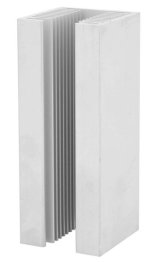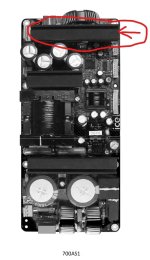Hello.
Those of you with a Icepower 700AS1: Hot hot are your heatsinks ?
I´ve got a Icepower 700AS1 up and running since 2 days.
Balanced input, driven by a SPL Volume 8, powering a 2*18" subwoofer (R DC = 2.7Ohm)
The heatsink HS1302 (the one next to the speaker output) gets quite hot.
Testsetup is on a flat board right now. Allround ventilation / free air / no case.
I know you can mount the heatsinks to the casing for heat dissipation. Which I will do lateron when putting it in a case.
Even with low power after a couple of minutes the heatsink HS1302 is getting very hot. I can only touch it for like 3 seconds, maybe 60°C I guess. Seems strange to me.
The amp works normal, protect LED is never on, its never shutting down, music sound real good.
The other two heatsinks on the board feel like 40°C.
I´m wodering if it´s normal for HS1302 to be "cooking" even with low power levels.
Before the 700AS1 the subwoofer was driven by Hypex FA251 or 501.
The plate of the Hypex Modules never got noticably warmer than body temperature.
What´s your experience with the 700AS1 ?
The 700AS1 shoudn´t be so hot with the same levels that the Hypex 251 handled while staying cold, should it ?
I have two Icepower 300AS1, those stay abolutely cold while playing music for several hours.
Cheers, Michael
Those of you with a Icepower 700AS1: Hot hot are your heatsinks ?
I´ve got a Icepower 700AS1 up and running since 2 days.
Balanced input, driven by a SPL Volume 8, powering a 2*18" subwoofer (R DC = 2.7Ohm)
The heatsink HS1302 (the one next to the speaker output) gets quite hot.
Testsetup is on a flat board right now. Allround ventilation / free air / no case.
I know you can mount the heatsinks to the casing for heat dissipation. Which I will do lateron when putting it in a case.
Even with low power after a couple of minutes the heatsink HS1302 is getting very hot. I can only touch it for like 3 seconds, maybe 60°C I guess. Seems strange to me.
The amp works normal, protect LED is never on, its never shutting down, music sound real good.
The other two heatsinks on the board feel like 40°C.
I´m wodering if it´s normal for HS1302 to be "cooking" even with low power levels.
Before the 700AS1 the subwoofer was driven by Hypex FA251 or 501.
The plate of the Hypex Modules never got noticably warmer than body temperature.
What´s your experience with the 700AS1 ?
The 700AS1 shoudn´t be so hot with the same levels that the Hypex 251 handled while staying cold, should it ?
I have two Icepower 300AS1, those stay abolutely cold while playing music for several hours.
Cheers, Michael
Attachments
I don't have an infrared thermometer.
But as far as I can tell, the temperature seems quite stable, whether in idle or playing music.
Maybe the 11W dissipation is enough to get that small heatsink warm/hot.
But as far as I can tell, the temperature seems quite stable, whether in idle or playing music.
Maybe the 11W dissipation is enough to get that small heatsink warm/hot.
It looks like someone else noticed that.The heatsink HS1302 (the one next to the speaker output) gets quite hot.
Since you said you're going to put it in the box, here are some ideas about that too.
Thanks. Yes, that was about the only thread I found when I did a Google search.
My case will be quite similar, but with more ventilation. I'll mount the 700AS1 vertical / heatsinks coupled to the sidewall. (40mm spacer and thread forming screws into the heatsinks) Vent holes in the bottom and top.
I didn't expect the heatsink to get so hot, because the icepower manual says you can put it in a case and run it as it is. Thermal coupling to the case is just optional, if higher thermal stability is needed.
I'd never put it in a case without further thermal coupling. Some of the capacitors are very close to the hot heatsinks.
My case will be quite similar, but with more ventilation. I'll mount the 700AS1 vertical / heatsinks coupled to the sidewall. (40mm spacer and thread forming screws into the heatsinks) Vent holes in the bottom and top.
I didn't expect the heatsink to get so hot, because the icepower manual says you can put it in a case and run it as it is. Thermal coupling to the case is just optional, if higher thermal stability is needed.
I'd never put it in a case without further thermal coupling. Some of the capacitors are very close to the hot heatsinks.
Yes, I would do the same.I'd never put it in a case without further thermal coupling.

Frankly I would never put it upside down with the heat sinks touching the bottom of the case.
Indeed, I would be generous with the box size, even in height because you might want to decide on to add heatsinks with higher fins.
Of course in summer we have to expect higher temperatures of the heatsinks too.
Last edited:
Thanks for your replay.
I bought a temperature sensor for my multitester and measured the heatsink temperature in idle and while listening to music.
With the testsetup (module flat mounted with 20mm spacers to bottom of case, no additional heatsink), it was indeed maxing out at apr. 52° surface temperature of the heatsink. (warm summer day, 27° room temperature)
I have built the case now. The case has a lot of room around the board, is very well vented (complete bottom and complete topside are perforated plate)
The board is mounted vertical with 20mm spacers to one sidewall.
And I have added a 40x40x100mm heatsink in vertical orientation.

The temperature of the onboard heatsink is now down to less than 44°C, according to my temperature sensor.
I think thats fine now and I don´t plan on adding a vent.
I bought a temperature sensor for my multitester and measured the heatsink temperature in idle and while listening to music.
With the testsetup (module flat mounted with 20mm spacers to bottom of case, no additional heatsink), it was indeed maxing out at apr. 52° surface temperature of the heatsink. (warm summer day, 27° room temperature)
I have built the case now. The case has a lot of room around the board, is very well vented (complete bottom and complete topside are perforated plate)
The board is mounted vertical with 20mm spacers to one sidewall.
And I have added a 40x40x100mm heatsink in vertical orientation.

The temperature of the onboard heatsink is now down to less than 44°C, according to my temperature sensor.
I think thats fine now and I don´t plan on adding a vent.
And yes a class D heats up.... Even volume lowered to the minimum....
It is due to the principle of cutting or PWM... Carrier frequency of the signal absorbed by the output filters, Only infineon (to my knowledge) has managed to create a pwm with 3 levels depending on the output power.
In my opinion no worries, even with a high load, given the efficiency, the temperature rise will be minimal.
It is due to the principle of cutting or PWM... Carrier frequency of the signal absorbed by the output filters, Only infineon (to my knowledge) has managed to create a pwm with 3 levels depending on the output power.
In my opinion no worries, even with a high load, given the efficiency, the temperature rise will be minimal.
Yes, the rise is minimal. I tracked the temperature over a couple of hours.
I was just confused by the 300AS1 amps not having a heatsink and not getting noticeable "hot" anywhere, while the 700AS1 was noticeable hot.
And by the manual stating something that read like "usually no additional heatsink needed".
Thanks everybody for pointing out it's normal and that adding a heatsink isn't unusual.
I was just confused by the 300AS1 amps not having a heatsink and not getting noticeable "hot" anywhere, while the 700AS1 was noticeable hot.
And by the manual stating something that read like "usually no additional heatsink needed".
Thanks everybody for pointing out it's normal and that adding a heatsink isn't unusual.
Yes, and please note that not only it's not unusual, but it is even recommended by a renowned manufacturer like Hypex.adding a heatsink isn't unusual.
"What becomes rapidly clear is that the SMPS and amplifier modules need some way of getting rid of heat. The
myth that “it’s class D so it doesn’t need cooling” is nothing more than that – a myth which is sometimes kept
alive by people simply turning palpating amps running idle. Some class D modules, particularly those opti-
mised for idle current rather than sound quality will indeed perform well in this test but unless their efficiency
at higher power is phenomenal the thermal performance at elevated power will be disastrous".
https://www.hypex.nl/media/b8/33/ac/1686146768/AN_Thermal_design.pdf
I have 1200AS2 though it's not 700AS1.
With the 35W idle power consumption the 1200AS2 can be quite hot without proper cooling.
The case I have has a fan to force cooling although the fan speed is very low. As long as there's air flowing the temperature would be much lower.
But perhaps that's because the chassis is too thin and small to provide enough passive cooling.
With the 35W idle power consumption the 1200AS2 can be quite hot without proper cooling.
The case I have has a fan to force cooling although the fan speed is very low. As long as there's air flowing the temperature would be much lower.
But perhaps that's because the chassis is too thin and small to provide enough passive cooling.
Yes, a forced air flowing is more efficient than simple convective motion related to (hot) air, and I've been thinking about it for a while, even if I think that when the "system" consistuted of cabinet-vents-heatsinks is adequately sized it's really useful only when room temperature is "high".As long as there's air flowing the temperature would be much lower.
However, room temperature becomes more critical with undersized systems consisting of cabinet-vents-heatsinks and poor airflow.
As usual, the combined action of more than one improvement leads to optimal results.
Yes, passive heat dissipation by a case does matter, but I think it is really important with those modules designed just for this purpose having a radiating surface that must be put in contact with the metal of the case.
According to Rod Elliot of ESP forced cooling can be up to 4 times more efficient that static heatsink cooling but in audio, noise, especially fan noise is your enemy. As a rule I tend to run fans slower than the spec as this reduces both vibration and air turbulence, use the biggest fan you can. Also I install rubber/silicon mounting kits. This reduces the transmission of vibrations to the case I use Akasa Rubber Case Fan Mounts.
Of course you must remember that fans have a limited life, although running them slower by reducing the voltage will extend that. The fan efficiency does reduce over its life so be careful to really read the specs on fans before purchasing or fitting.
Of course you must remember that fans have a limited life, although running them slower by reducing the voltage will extend that. The fan efficiency does reduce over its life so be careful to really read the specs on fans before purchasing or fitting.
- Home
- Amplifiers
- Class D
- ICEpower 700AS1 - how hot is to hot ?
